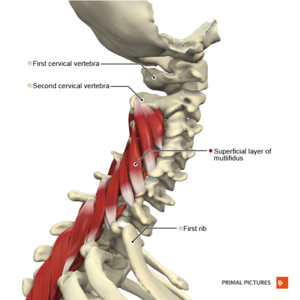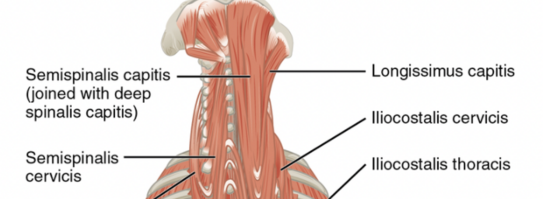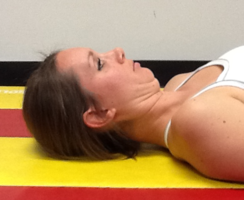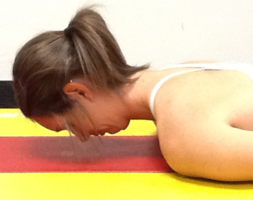Cervical Deep Neck Extensors
Original Editor - Lucinda hampton
Top Contributors - Lucinda hampton and Kim Jackson
Introduction[edit | edit source]
The deep neck extensors (DCE) provide stability and control for the neck, being anatomically able to control segmental movements of the cervical spine in concert with the deep cervical flexors.[1] Neck extensor muscles needs to control the head (which can weigh an average of 4.5kg), and for this they need sufficient strength.
The deep neck extensors muscles belong to the deepest layer of intrinsic back muscles, the transversospinalis group. They provide posterior support of cervical lordosis in synergy with the deep neck flexors and prevent a forward head position.[2] The DCE muscles are:
- Semispinalis cervicis - which acts a cervical extender, and maintains head posture
- Multifidus - which acts as a segmental stabiliser as the spine moves. It is thought that the unique design of the multifidus endows it with extra strength[2]
If the DCE muscles become impaired eg in cervical spine disorders, this will lead to key functional restrictions and pain.[3]
Pain Mediated Changes[edit | edit source]
Research has shown that both the cervical flexors and extensors lose strength and endurance in the presence of neck pain, and that co-activation of ceases especially with functional tasks.
- Structural changes such as higher concentration of fat within the muscle, variable cross-sectional area and higher proportions of type II fibres have been observed in the deep cervical extensors of patients with neck pain compared to healthy controls. These findings suggest that the behaviour of the deep extensors may be altered in patients with neck pain.
- A recent series of studies confirm that patients display reduced activation of the deep cervical extensors as well as less defined activation patterns.
- Changes in function in the deep cervical muscles has an influence on function as it affects the support and control of the cervical spine and could lead to overload on specific segments[1].
Physiotherapy[edit | edit source]
The Head/Neck Extension Test can be used to assess cervical extensor muscle balance.
- With the patient lying prone and head and neck past the edge of the table and the cervico-thoracic junction stabilized
- The ability of the individual to sustain a chin tuck position in neutral for 20 s is evaluated.
- Assess the pattern of muscle contraction as the head lifts. Normally the Levator Scapula and Upper Trapezius should remain relaxed, palpate these muscles during the movement to confirm. These are superficial back muscles
- Failure of any portion of the Head/Neck Extension Test is an indication of cervical extensor dysfunction. A positive finding for weakness of the deep neck extensors is the 'chin length' increasing with neck extension, indicating a dominance of the superficial extensors of the neck. Additionally there will be hyper-extension of the upper cervical spine with excessive flexion and anterior shear of the lower cervical spine[4][5].
If there is a deficit in deep extensor muscle strength corrective exercises to resolve stability muscles to normal should be taught and prescribed, potentially facilitating chronic neck pain resolution.
Corrective Neck Exercises
The head retracted/chin tucked position is the starting point with all of these exercises. The patient should be familiar with this movement before progressing to these extension exercises.
OA flexion (chin tuck): A slight nod while keeping your head in neutral: Have the patient tuck their chin in towards their neck. Then press the back of the head into the book. The chin must remain tucked as they do this.
Extension with chin tuck: While laying on your stomach tuck your chin, lift your head off table while maintaining chin tuck and hold 3-5 seconds
Cervical Extensor Exercise Progressions Examples
Extension with chin tuck: While laying on your stomach tuck your chin, lift your head off table while maintaining chin tuck and hold 3-5 seconds
In quadruped position. In this posture the neck extensors must contract to hold the head and neck in proper alignment against gravity. Ensure the shoulder blades are relaxed and the thoracic and lumbar spines are in a neutral posture. From this position tuck the chin towards the neck, then gently extend the head back towards the ceiling.
Shoulder motions can be added to to progress the Quadruped Neck Retraction / Extension exercise. Arms can do single lifts in any direction, and light weights will further increase the demand on the neck musculature is further.[5]
This less than 2 minute video shows neck extensor exercises, with reps given.
References[edit | edit source]
- ↑ 1.0 1.1 Schomacher J, Falla D. Function and structure of the deep cervical extensor muscles in patients with neck pain. Manual therapy. 2013 Oct 1;18(5):360-6. Available:https://www.mskscienceandpractice.com/article/S1356-689X(13)00087-8/pdf (accessed 9.2.2022)
- ↑ 2.0 2.1 Peng B, Yang L, Li Y, Liu T, Liu Y. Cervical proprioception Impairment in neck pain-pathophysiology, clinical evaluation, and management: a narrative review. Pain and Therapy. 2021 Jun;10(1):143-64. Available: https://www.ncbi.nlm.nih.gov/pmc/articles/PMC8119582/(accessed 9.2,2022)
- ↑ Rebbeck, Aguila M, Desa V, Shirley D, Clarke J, Leaver A. Discipline of Physiotherapy, Faculty of Health Sciences, University of Sydney. How to assess contraction of the cervical deep muscle extensors using realtime ultrasound Available: http://www.specialistphysioeducation.net.au/pdfs/HOW_TO_assess_DCE_using_RTUS_participant_HANDOUT.pdf(accessed 9.2.2022)
- ↑ Sebastian D, Chovvath R, Malladi R. Cervical extensor endurance test: a reliability study. Journal of bodywork and movement therapies. 2015 Apr 1;19(2):213-6. Available:https://pubmed.ncbi.nlm.nih.gov/25892374/ (accessed 9.2.2022)
- ↑ 5.0 5.1 Mr rehab connection Cervical muscle dysfunction Available: https://myrehabconnection.com/cervical-extensor-exercise-progressions/(accessed 9.2.2022)
- ↑ CGGI. Neck extensor strengthening. Available from: https://www.youtube.com/watch?v=HbLiEFFH2Sg [last accessed 10.2.2022]










